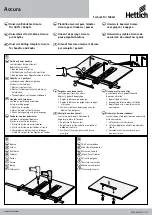
Deltapilot S
28
Hauser
Proof-test
Proof-test
Safety functions must be tested at appropriate intervals to ensure that they are functioning correctly and are
safe.
The intervals have to be specified by the operator (
8, "Proof-test interval" graphic).
The test must be carried out in such a way that it is proven that the protection equipment functions perfectly
in interaction with all the components.
The following section describes two possible procedures for recurrent testing to uncover dangerous undetected
device failures. They differ in terms of the percent rate of detection.
Proof-test 1:
This test detects approx. 50 % of the possible dangerous undetected device failures.
1.
Bypass safety PLC or take other suitable measures to prevent alarms from being triggered by mistake.
2.
Disable locking.
27, "Locking/Unlocking" section.
3.
Set the current output of the transmitter to HI alarm via a HART command or by means of the on-site
display and check whether the analog current signal reaches this value.
– e.g. simulate an alarm by means of the SIMULATION MODE and SIM. ERROR NO. parameters.
This test detects problems based on voltages that are not compliant with the standard, e.g. due to too low
a current loop supply voltage or increased cable resistance, and checks possible faults in the transmitter
electronics.
4.
Set the current output of the transmitter to LO alarm via a HART command or by means of the on-site
display and check whether the analog current signal reaches this value.
– e.g. set the ALARM RESPONSE parameter to "Min. alarm".
– Simulate an alarm by means of the SIMULATION MODE and SIM. ERROR NO. parameters.
This test detects any problems in conjunction with quiescent currents.
5.
Restore the complete operativeness of the current loop.
6.
Disable safety PLC bypassing or restore normal operation in some other way.
7.
Once the recurrent test has been carried out, the results must be documented and stored in a suitable
manner.
Proof-test 2:
This test detects approx. 99 % of the possible dangerous undetected device failures.
1.
Perform steps 1 to 4 outlined under recurrent test 1.
2.
Compare the pressure measured value displayed to the pressure present and check the current output.
During this test, suitable processes, measuring resources and references must be used.
– For the lower-range value (4 mA value) and the upper-range value (20 mA value), compare the
pressure present to the measured pressure.
– If the measured pressure deviates from the pressure present at the device, the reference pressure
present must be reassigned to the 4 mA value and the 20 mA value.
For the 4 mA value,
→
Operating Instructions BA274P, parameter descriptions for SET LRV (245) and
GET LRV (309) for pressure measurement, SET LRV (013) for level measurement (LEVEL SELECTION
"Level Easy Pressure").
For the 20 mA value,
→
Operating Instructions BA274P, parameter descriptions for SET URV (246)
and GET URV (310) for pressure measurement, SET URV (012) for level measurement (LEVEL
SELECTION "Level Easy Pressure").
3.
Perform steps 5 to 7 outlined under recurrent test 1.
!
Note!
Regarding Step 2 of proof-test 2:
After this procedure, the current value is output correctly. The value displayed, e.g. on the on-site display, and
the digital value via HART can deviate from the pressure actually present. If the display value and digital value
are also to be corrected, please contact Hauser Service.
Содержание Deltapilot S FMB70
Страница 30: ...Deltapilot S 30 Endress Hauser Management summary Management_summary exida_2 Management_summary exida_1 ...
Страница 31: ...Deltapilot S Endress Hauser 31 Management_summary exida_3 ...
Страница 32: ...Deltapilot S 32 Endress Hauser Certificate TUEV_en ...
Страница 33: ...Deltapilot S Endress Hauser 33 ...









































